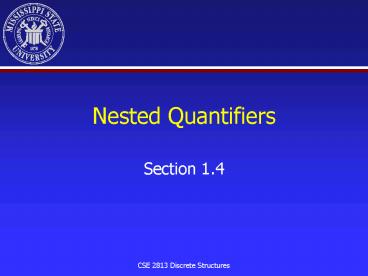Nested Quantifiers - PowerPoint PPT Presentation
1 / 13
Title:
Nested Quantifiers
Description:
A predicate becomes a proposition if the variable(s) contained ... U = {all integers} The sum of two positive integers is positive. CSE 2813 Discrete Structures ... – PowerPoint PPT presentation
Number of Views:352
Avg rating:3.0/5.0
Title: Nested Quantifiers
1
Nested Quantifiers
- Section 1.4
2
Recap Section 1.3
- A predicate is generalization of a proposition.
- It is a proposition that contains variables.
- A predicate becomes a proposition if the
variable(s) contained is(are) - Assigned specific value(s)
- Quantified
- Universe of discourse the particular domain
of the variable in a propositional function
3
Recap Section 1.3
- Universal quantification
- P(x) is true for ALL the values of x in the
universe of discourse. - ?x P(x).
- Remember ? ? All.
- for all x, P(x)
- If the elements in the universe of discourse can
be listed, U x1, x2, , xn - ?x P(x) ? P(x1) ? P(x2) ? ? P(xn)
4
Recap Section 1.3
- Existential quantification
- P(x) is true FOR SOME x in the universe of
discourse, i.e. EXIST some x - ?x P(x)
- Remember, ? ? Exist
- for some x, P(x)
- If the elements in the universe of discourse can
be listed, U x1, x2, , xn - ?x P(x) ? P(x1) ? P(x2) ? ? P(xn)
5
Recap Section 1.3
- Universal quantifiers usually take implications
- All CS students are smart students.
- ?x C(x) ? S(x)
- Existential quantifiers usually take conjunctions
- Some CS students are smart students.
- ?x C(x) ? S(x)
6
Recap Section 1.3Summary of quantifiers
- ?x P(x)
- True when P(x) is true for every x
- False when P(x) is false for at least one x.
- ?x P(x)
- True when P(x) is true for at least one x
- False when P(x) is false for every x
- Negation changes a universal to an existential
and vice versa, and negates the predicate - ?x P(x) ? ?x P(x)
- ?x P(x) ? ?x P(x)
7
Recap Section 1.3Quick examples
- (13b) Determine truth value. UZ
- ? n (2n 3n)
- (16b) Determine truth value UR
- ? n (x2 -1)
- Exercise 17
8
Nested Quantifiers
- Quantifiers that occur within the scope of other
quantifiers - Example
- P(x,y) x y 0, UR
- ?x ?y P(x,y)
9
Quantifications of Two Variables
- For all pair x,y P(x,y).
- ?x?y P(x,y) ?y?x P(x,y)
- For every x there is a y such that P(x,y).
- ?x?y P(x,y)
- There is an x such that P(x,y) for all y.
- ?x?y P(x,y)
- There is a pair x,y such that P(x,y).
- ?x?y P(x,y) ?y?x P(x,y)
10
Translating statements with nested quantifiers
- U all real numbers
- ?x ?y (x y y x)
- ?x ?y (x y 0)
- ?x ?y ( (x gt 0) ? (y lt 0) ? (xy lt 0) )
- U all students in cs2813
- C(x) x has a computer
- F(x,y) x and y are friends
- ?x ( C(x) ? ?y (C(y) ? F(x,y)) )
11
Translating Sentences
- U all people
- If a person is female and is a parent, then this
person is someones mother. - U all integers
- The sum of two positive integers is positive.
12
Is the order of quantifiers important?
- If the quantifiers are of the same type, then
order does not matter - If the quantifiers are of different types, then
order is important
13
Example
- UR
- Q(x,y) xy0
- What are the truth values for
- ?y ?x Q(x,y) and ?x ?y Q(x,y)
- ?y ?x Q(x,y) There exist at least one y such
that for every real number x, Q(x,y) is true,
i.e. xy0. - FALSE (not for every, only when y is x).
- But
- ?x ?y Q(x,y) For every real number x, there is a
real number y such that Q(x,y) is true, i.e xy
0. - TRUE (for every x when y is x)































